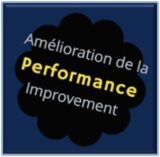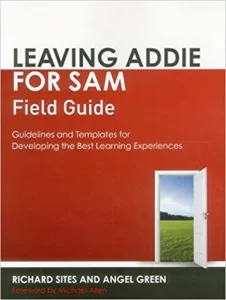Instructional Design vs Training Engineering
Instructional Design differs from Training Engineering as where Pedagogical Design refers to practice, Training Engineering is focused on competence development and relies on the competency-based approach. It is a cohesive and methodological process that is set forward to develop actions or training tools to efficiently reach the targeted objective, or the mastering of the competences by the employees.
Instructional Design is therefore a part of the global Training Engineering process in industry when the competency-based approach is implemented. The Instructional Design is based on learning objectives rather than competence development, and it is essential for the development of targeted training modules.
Instructional design consists of
- Analyzing a learning context.
- Determining the learning needs within that context.
- Developing strategies to help create what is needed for learning using:
- Pedagogical strategies.
- Matierial.
- Learning theories, and
- Pedagogical Design models.
- Evaluating the training modules and the methods used for the transfer of learnings.
There are a multitude of instructional design models as well as pedagogical models (ADDIE, SAT, SAM, Merrill, Bloom, Dick and Carey, ISD, Gagné’s (NEI – Nine Events of Instruction), IPDM, OEM and others. I will be covering 2 of those models: ADDIE (Analyze, Design, Develop, Implement, Evaluate) and SAM Instructional Design Model (Successive Approximation Model), le latter being the most recent of the 2.
Agile for Instructional Designers
The 2 books suggested below can help you greatly to improvement of your instructional design process.
ADDIE – Generic instructional design model
The ADDIE model is certainly one of the best known and used, even if it dates back many years, this model can be applied to almost any context and pedagogical situations, the reason why it is used by a large majority of the oldest instructional designers. Some find it out of date, but it is still one of the easiest models, and when applied correctly, can bring very good results.
The model is structured, easy to follow and based on learning objectives and gives clear directions once the design specifications are completed.
But many find it laborious to follow, too linear, since it is sometimes hard to foresee the problems or changes to come or that we may encounter along the way, plus a lack of communication could stop the whole process. It is also hard to go back because it could involve the modification of the whole design.
We must therefore think the whole thing from the start and follow all design specifications to the letter to prevent redoing everything. On top of that, each phase must be completed before going to the next one, preventing the developers to work on multiple steps at a time.
To deliver a pedagogical project, the ADDIE model is based on 5 phases.
Schedule validation sessions at the end of each of the 5 phases of the project as well as a starting session at the beginning with the client/requestor, to present the project and receive approval.
The ADDIE model is based on 5 phases in order to deliver a pedagogical project.
Summarized representation of the ADDIE instructional model
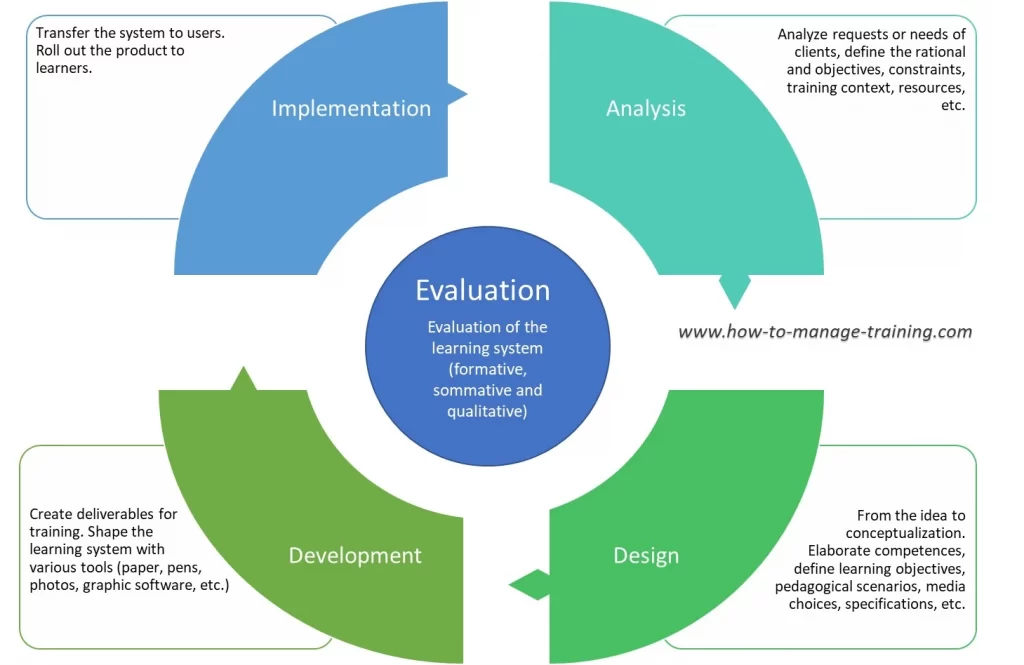
1. Analyze
This first phase must be completed very meticulously. This phase is the core around which you will base your whole instructional design and it is often completed too lightly. A course is taken to fill a behavioural gap, so it is important to determine this gap with extreme accuracy at the very beginning.
We want to know: the expected performance, the actual performance, why can’t we perform the way we want and what are the gaps needed to fill to reach the desired performance?
The client doesn’t want more, or less of what he asked for and will not pay for something he doesn’t need or didn’t want. Get used to, while staying creative, deliver exactly what the client is expected to receive.
Important note: Never take for granted that the content they say they have is complete. Often during the analyzing phase, content experts will tell you that they have all the content, unfortunately this content is sometimes unusable, or they send you a truck load of documents that will make you waste numerous hours of valuable time, especially if you’re a consultant and your hours are all accompted for.
The following elments must b e analyzed:
- What is the goal (rational) of the training to be developed? Why do we have to train employees on this subject?
There must be a reason why the client/requestor wants to train his/her employees, you need to figure it out. - What is the organizational context? Or how would you describe the situation?
At this stage, it is extremely important that the client/requestor specifies the exact actual situation and the desired situation following training. - Which competences must be mastered by the employees and why don’t they master them?
- What is expected at the end of the training (final objective, knowledge, know-hows, and behaviors)?
- What is the audience (technicians, managers, engineers, contractors, etc.)? Can we eventually expand the audience with the same training package? (Think carefully about this point before starting your design).
- Which training strategies are you planning to use (existing internal or external training modules, required development, etc.)
- What is the expected duration?
- When will the training materiel be required to start the first session?
- Are there any constraints (distance, availability of the leaners, technology, internet speed, etc.)?
- Do you need translation?
- What are de deliverables?
- How will you measure the expected results?
- Is the content available and sorted?
- Who will be the trainer(s)?
- Who will be the content experts?
- Who will validate the final products?
- Determine the budget:
- What is the timeline?
- Where will the training take place?
- How many classrooms are required?
- How many training sessions?
- How many trainees per sessions (min/max)?
- What equipment is needed?
- When will the sessions take place (time)?
- Do you need software?
- Do you require to order meals?
The more precise and detailed your analysis is, the easier it will be to satisfy the needs of your client and prevent redoing a part or the whole work.
2. Design
This phase comprises 2 levels of intervention: the macro-design or the general architecture of the learning system and the micro-design which consists of the design of all components of the learning system.
In this phase we must specify:
- The learning objectives of the learners. These objectives must be formulated from the learners’ perspective.
- The media that will be used during training.
- The design specifications.
- The pedagogical scenarios.
- The various learning activities.
- The task aids.
- The procedures, the standard operating procedures, the work plans, etc. that will be used during training.
- The evaluations to be used.
3. Development
This phase consists of materializing the training tools and material specified during the design phase.
To do this, we need various tools and equipment (paper, pens, pencils, photographic and video equipment, television, software, graphic design, and all other tools).
This may include: Un trainer’s guide, an exercise book, training revisions (evaluations), a training evaluation, pedagogical activities, posters, PowerPoints, eLearning, virtual training systems, etc.
4. Implementation
Because no body is perfect, the implementation phase or dissemination phase is normally done in 2 steps.
- A pilot group (or first group) to whom the training will be disseminated and tested. Following this first session, we make improvements and corrections (like the length, the practical exercises, the demonstrations, the trainers, etc.) to improve the next sessions to come.
- We disseminate to all identified employees.
This phase consists of making the entire learning activities available to the learners. To do this we need an organizational and technological structure. Whether the training is online or in class, it is the time when the trainer uses all the principles enumerated in “Conduct a training session”.
5. Evaluation
The goal of this important 5th phase is to evaluate the learning system to validate its quality and efficiency.
This phase is also critical to guaranty that the training and material, as well as the trainers/facilitators, meet the expected results stated in the needs analysis and fully fills the identified competence gaps.
We can also evaluate the learning system throughout the pedagogical design process to prevent redoing a good part of it at the end of the pedagogical design.
Check out the evaluation advises according to Kirkpatrick’s model!
Variants of ADDIE – ADDIEM and PADDIEM
ADDIEM
The “M” at the end of ADDIE M, is simply the addition of a phase called maintenance which allows to improve the tools and resources used during training.
Personally, I think it is not necessary since we already evaluate the efficiency of the tools, the trainers and the transfer or learnings during the evaluation phase of ADDIE.
If we follow the ADDIE model to the letter, the M phase becomes obsolete.
PADDIEM
As far as “P” ADDIE M is concerned, it was developed by the U.S. Navy, in addition to the maintenance phase, they added another phase for “planning” which fixes a temporary timeline to the design project as well as a budget, the stakeholders and additional resources.
Her again, if we follow the ADDIE model, the design timeline, the budget elements, the stakeholders, and additional resources are already considered during the analysis phase. Maybe the U.S. Navy had to specify these for their specific needs, but I don’t believe they need to be added.
SAM (Successive Approximation Model)
The SAM model is a more cyclic process than the 5 phases of ADDIE and it is easier to adapt for the design of eLearning projects when the goal is to modify the learner’s behavior.
This model is based on the Agile project management approach: The Agile project management, supported by a specific Agile project management software, is an iterative design methodology (steps or instructions repeated often) that prioritizes human communication and feedbacks and easily adapts to changes to produce tangible and functional results. This approach comprises 12 principles, the first and most import being: Client satisfaction.
This model is a combination of ADDIE and Rapid Prototyping and it perfectly suitable for the design of eLearning courses.
There are 2 models of SAM, SAM 1 and SAM 2. Depending on your requirements, it is possible to use one of the 2 models.
Which is the best Instructional Design Model – ADDIE or SAM?
- SAM, because of its flexibility and Agile approach, is ideal in situations where all participants are fully motivated and committed and allows the delivery of a final course very quickly. Its iterative approach helps you, when using the prototype, get a quick buy-in from the stakeholders but also pivot quickly if the learning requirements change.
- However, many organizations have embraced the Agile approach in theory only more than in practice.
- Applying an Agile approach like SAM in an environment that does not support quick feedbacks, or a flexible process can be difficult. In this case, the instructional mode ADDIE could be a better choice.
- Since the ADDIE model has been used for many years, it could make the stakeholders, clients and team members feel more comfortable. Even if it is not as flexible as the SAM instructional model, many people use an adapted version of ADDIE which includes iteratives cycles, a mix between the 2 that produces good results, which I highly recommend for non-eLearning courses.
Nevertheless, whatever method or approach you use, ADDIE, SAM, or others, it is extremely important to evaluate all of your options. Reactive practices of design can be a very good way of building collaboration and get ready for a smooth roll out of your training courses.
Check out: Agile Methodology eLearning – delivered by expert practioners from Rolls-Royce
An Agile platform to manage any types of projects
From very easy projects to the most complex portfolios, managing teams get the best out of their work with monday.com. Join over 125,000 teams using monday.com in 14 different languages. No training needed!
the individual FREE version includes: Unlimited boards, Unlimited documents, 200+ Templates, Over 20 column types, Up to 2 team members and iOS and Android apps.
Unlimited boards and workflows. No credit card needed.
Creative planning of all your projects
An Agile management software, FREE for life, (individual plan for 2 users), for those who want to keep track of their projects absolutely free.
12 principles of Agile project management (summary)
Agile is based on 4 core values:
- Individuals and interactions over processes and tools.
- A working software over exhaustive documentation.
- Client collaboration over contract signature.
- Reaction to changes over following a detailed plan.
Client satisfaction is measured by quick and continuous delivery of value-added software.
All changes are considered and welcomed for the improvement of the deliverables.
A part or a section of a software must be deliverable frequently to learners.
Daily meetings are planned and essential for the results and client satisfaction.
Select a team at your required level of expectations.
Nothing beats face-to-face meetings for a better understanding of issues and bring up good and bad practices.
Work step by step and be ready to deliver a functional part of workable product at regular intervals to your client.
A project tracking with regular short-term milestones to better measure the progress is a must.
Validate all techniques and design throughout the project.
Keep track of what is left to be done.
Ensure your teams are well organized to increase creativity and best practices.
Continuous improvement is the key to success of an Agile project.
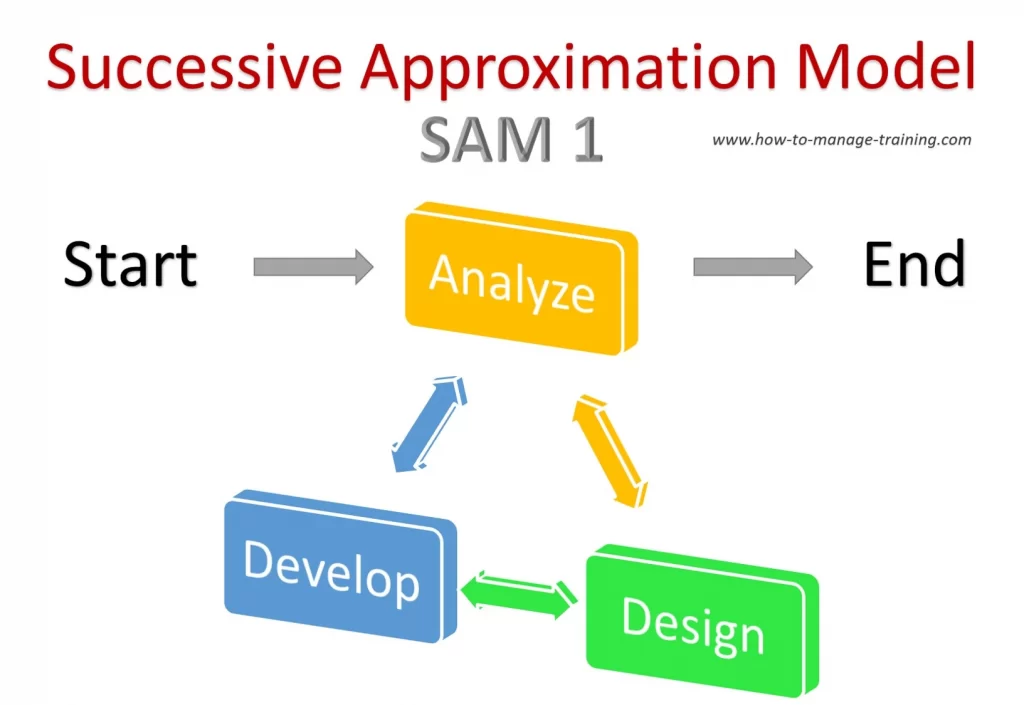
SAM 1 - Instructional Design Model
The pedagogical design model SAM 1 is cyclical and consists of 3 classic design phases: Analysis, Design and Development.
The analysis, the design and development are done the same way as with the ADDIE model, with the exception that they are not sequential, because we can go back as often as required or iterate the same cycle many times.
It is perfectly adapted to small eLearning projects where you don’t have to use complex technology or when you have a small team.
This basic iterative approach allows each member to discuss, prototype and test ideas and hypothesis at the very beginning and all along the design process. This allows quick adjustments during the design cycle and can produce quicker usable material.
The model gives you a taste of the results at each step of the design process.
Plus, by making changes downstream, it is way easier to modify without adding time and costs to the design project.
However, if your project is larger or you are part of large team, it is preferable to use the SAM 2 model.
Field Guide - Leave Addie for SAM
This easy to use guide includes simple agile templates to develop the best learning experiences following the SAM instructional design model for an intelligent start. It contains, job aids, tools, templates you need to kick off the SAM methodologie on the right foot. It is a must have book to create the best learning products quickly by following the Agile project management approach.
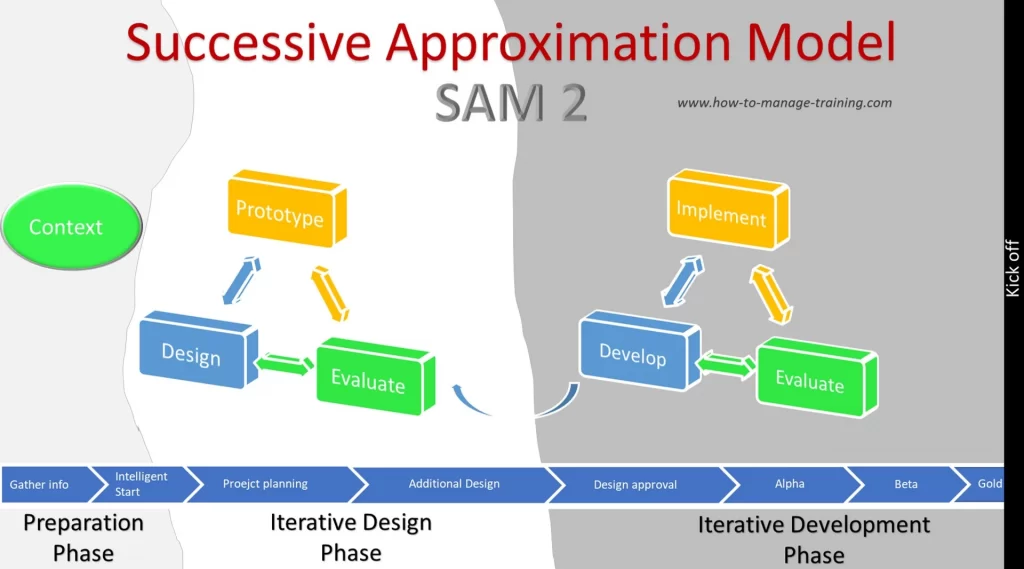
SAM 2 - Instructional Design Model
The instructional design model SAM 2 is comparable to the ADDIE model with the exception that each step of the model is designed to be prototyped and validated as the design is being created.
Schedule an intelligent start up meeting at the beginning of the project with the client/requestor to present the project and have it accepted, as well as meetings at the end of each step of the phases.
This model is divided in 3 phases: Preparation, Design and Development.
Preparation Phase
This phase includes the context analysis as well as 2 steps: Information gathering while completing the Intelligent start up.
Information Gathering
The information gathering is the equivalent to the needs analysis found in ADDIE. It has all the same steps a training needs analysis has:
- What is the goal (rational) of the training to be developed? Why do we have to train employees on this subject?
There must be a reason why the client/requestor wants to train his/her employees, you need to figure it out. - What is the organizational context? Or how would you describe the situation?
At this stage, it is extremely important that the client/requestor specifies the exact actual situation and the desired situation following training. - Which competences must be mastered by the employees and why don’t they master them?
- Etc.
- Please refer to ADDIE above for all the details.
Intelligent start-up meeting
The intelligent start up consists of meeting with all team members of the design project with the client/requestor and their participants to collect and gather all information from both sides and to clarify the needs, the expectations and decide on the project design.
Iterative Design Phase
This phase has 2 steps: The planning of the project and Additional Design
Planning of the project
It is at this step that we prepare the design calendar or mapping of the project
- Who will do what and when?
- What are the deliverables and when will they be delivered?
- Who will validate and when?
- Etc.
Using the information gathered during the Phase 1, we design a deliverable prototype.
We recommend an Agile planning tool like Monday to layout your project and assign all tasks, dates, milestones…
Additional Design
Once the prototype completed, the team review the whole design to allow the best possible pedagogical design.
If we’re not satisfied or the client is not satisfied, we go back to the design and prototype and improve until the final design is accepted by the client.
We iterate like this as many times as needed.
Iterative Development Phase
Once the team has agreed on the design, the project moves forward in a continuous cycle of development, implementation, and evaluation.
It is very important at this stage to develop only small parts of the project to ensure you always have something usable to deliver to the final users. This gives them the ability to give feedbacks often and reinforces the great advantage of this pedagogical design model.
This is the major difference with the ADDIE model, that waits till the end of the project before getting feedbacks. SAM always produces a quick usable product that learners can use and interact during each stage of development.
Implementation of Alpha, Beta and Gold
The Alpha phase, as with ADDIE, serves as a first version or pilot version of the project. At this stage, all components of the training are usable from beginning to end. This includes learners’ interactions in the form electronic formative feedback cycle. There should not be major problems to be discovered, but it is normal to find small editing improvements to be made.
The Beta and Gold are the Roll out phases with the final components
The Beta phase is a modified version of the Alpha phase based on feedbacks and final reviews. It is not that rare that the Beta phase becomes the Gold phase of the project. The Beta phase is also an opportunity for a final review and correct the project based on feedbacks from phase Alpha.
Once final corrections are made, the project moves on to the Gold phase and its ready for the complete Roll out.
In conclusion, SAM allows designers to test their training material early on as well as being agile to revisions based on feedbacks. The continuous revision cycle is used as a catalyst to allow a better cohesion and flexibility of the project during regular changes to the learning objectives.
Adapted version of Agile for instructional designers
Megan Torrance, consultant and founder of TorranceLearning, has created with colleagues and consultants a modified version of Agile specifically for Instructional Designers for her consulting firm.
They name it “LLAMA” for “LOT Like Agile Management Approach” and have been using it since 2012 for the design and development of softwares, instructional designs, eLearnings and other forms of learning material.
I strongly suggest to read this book “Agile for Instrucational Designers” and apply her method in all of your design projetcs. It is available on Amazon and Bookdepository, depending on where you want it ship to.
AGILE for instructional designers, Amazon
AGILE for instructional designers, Bookdepository
Extract from the book:
“Recognizing that software development and instructional design have different needs and outcomes, author Megan Torrance developed the LLAMA (TM) methodology. Her approach adapts the common phases of ADDIE to incorporate the incremental, iterative nature of Agile projects. It allows learners to test and evaluate which features or design functions work before they’re finalized. It also offers a way to accommodate inevitable mid-project modifications pushed by stakeholders, subject matter experts, or organizational leaders.
With templates for goal alignment, learner personas, scope definition, estimating, planning, and iterative development, Agile for Instructional Designers is the resource you need to embrace change in learning and development.”
